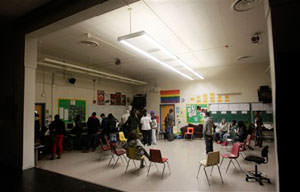Second-Class Students
In a recent interview, Oakland Unified School District Superintendent Tony Smith shared with me one of the most mind-numbing statistics I have ever heard.
In a recent interview, Oakland Unified School District Superintendent Tony Smith shared with me one of the most mind-numbing statistics I have ever heard: According to the Alameda County Health Department, a black child born in West Oakland will, on average, die 15 years before a white child born in the hills of Oakland.
“Surely this must be enhanced or inflated for shock value,” I said to Smith. “This can’t be real.”
“That is a real statistic that exposes serious inequity along racial lines in Oakland,” said Smith. We sat for a minute talking about our hopes for our children and our hopes for Oakland schools, but the statistic stung me with a viscous dose of reality, which quickly transformed into deep concern and doubt about Oakland’s education system.
I imagined being a young, black student in 2011 and hearing that statistic — not only hearing it, but feeling the piercing reality of it every day I go to school. The dilapidated flatlands classrooms, the out-of-date texts and lack of technology — the message would be clear: They (whoever “they” are) don’t care about me or anyone who looks like me.
The question is will I live no one in the world loves me I’m headed for danger don’t trust strangers Put one in the chamber whenever I’m feelin this anger Don’t want to make excuses but this is how it is, what’s the use Unless we’re shootin, no one notices the youth. It’s just me against the world. — Tupac Shakur, “Me Against the World,” 1995
This statistic shows that two realities exist in Oakland, one for children and families with resources, and a daunting, painful second one for those children and families without resources. It would be myopic to suggest that the education problem in Oakland is all about race, because it’s not. That black children are dying at an alarming rate and underperforming in schools compared with their classmates of different races is a problem so complex it troubles me to write about it. But black children are not the only victims. What is happening in the predominantly black public schools in Oakland is indicative of what is happening in poor public schools around the nation. The unfortunate fact is that in Oakland, black and Latino people represent the large majority of the poor underclass.
Don’t get me wrong. Oakland education is not all bad. It is only bad where families do not have time, money and resources to dedicate to their schools. I have seen public schools in the worst neighborhoods thrive. Think College Now has managed to build a haven for children to learn their curriculum and about themselves. Before I visited that school, at 29th and International — one of Oakland’s high-crime and high-poverty areas — I doubted it was possible. But when I went there I saw principal David Silver and his teachers breathing life and love into children and beating the odds. I saw parents attending the morning assembly to send their kids off to class. I saw magic. Through community, all things are possible. This was my proof.
At Crocker, Montclair, Redwood Heights and the handful of other schools in Oakland that have continued to succeed despite the economic downturn or lack of funding to public schools, the story is the same: Involved parents and solid communication between the teachers and students make for a combination that gets the job done. Success is indeed possible in both the richest and poorest communities.
However, of the 14 predominantly black public elementary schools in Oakland — most of them in poor communities where the black student population is 60 percent or more — only two are performing with API scores above 800 (a state proficiency requirement), the Carl Munck and Burkhalter schools.
If we see examples of success in all types of communities around Oakland, then why isn’t it happening across the board? Why are the predominantly black schools underperforming? My family has lived in Oakland since 1950. All of my family went to public schools and — let them tell it — received an excellent education. My father says his Oakland Technical High School education prepared him for life.
But it’s clear to me after talking to graduates of today’s Oakland high schools that the quality of education in the system has dramatically declined. I spoke to one graduate of Oakland High’s Class of 2003 recently at Luka’s Taproom who said of her education: “It was all right — it was the best Oakland could do.” Have we come to settle for mediocrity? The trends show that people are giving up on Oakland public education. Over the last decade Oakland public schools have lost nearly 30 percent of their students, with enrollment declining from 54,024 in 2000 to 38,446 in 2010, and an increasing number of families are choosing either charter, private, or parochial schools.
The population loss and divergence make sense when you consider how much money has been cut from the Oakland Unified School District budget in the last 20 years. Budget cut after budget cut has left the school district today funded at the level of the 2005-06 school year, according to OUSD statistics. And such cuts always have a more devastating effect on poor and under-resourced students and families.After a state takeover of the OUSD in 2003, which produced some good results and helped make Oakland the most improved district in California in the last six years, Oakland is left wondering what it will be forced to cut next. Now the state is asking the OUSD to cut its per-pupil expense by $850, and the district is trying to figure out ways to make those cuts less severe.
Superintendent Smith explained to me that there has been an erosion of school finance and education finance in California since 1975. “Before 1975, California was the most well-funded and high-quality public school system in the United States,” says Smith.
California’s Proposition 13, he says, changed everything, severely altering the fundamentals of school finance and school funding across the state. According to the California Budget Project, “immediately prior to the passage of Proposition 13, local revenues provided nearly half (47.1 percent) of the funding for California’s public schools. Today, with Prop 13 in place, our schools are forced to rely on Sacramento for most of their funding and our revenue-starved state has not kept up with its obligations.”
“We’ve seen a steady degradation of core systems,” says Smith. “I also think we’ve seen an expansion and broadening of the needs. So you have two things happening simultaneously, less and less funding and an increase of need.”
And here we go again. Spring has come to Oakland, but it will be another long and cold winter in the school district: Gov. Jerry Brown on March 30 announced the end of talks with Republican legislators because he could not garner the necessary support to put about $12 billion in temporary tax increases on a June ballot.
The result of this failed negotiation is that California public school students get screwed again and the state Legislature gets more time to decide just how it wants state money to be spent. Shortfalls are happening in cities all over the country. Camden, N.J., Detroit, St. Louis and New York all face challenges similar to Oakland’s as state budget cuts mean larger classes, fewer schools and less money to pay deserving teachers. When is enough going to be enough?
Oakland is used to budget cuts. The city itself is currently working to close a $46 million deficit, trying everything to increase tax revenue, from legalizing industrial marijuana growth to generating new partnerships with green builders and developers. But it’s not happening fast enough. Despite the recent re-hiring of 10 of the 80 police officers it had to fire in 2010, Oakland continues to struggle with rampant crime problems and still sits atop the list of the most deadly cities in the United States.
Governors and other leaders around the country are singing the same tune: We have no choice but to make these cuts. If there was another way, we would take that route. No one wants to shortchange the students. Oh, how familiar the sound. Our leaders say these things as though they have no ramifications — as though a student isn’t getting a raw deal. Today is the day we must stand up and say enough is enough.
“It’s not just what’s happening to our young people, but what’s going to happen to our country as a consequence of what’s happening to our young people,” says Dr. Harry Edwards, professor emeritus at UC Berkeley.
“Young black kids typically pave the road that other members of the youth culture eventually travel. Whether it’s drugs, illegitimacy, crime, whether it’s their disposition and perspective on education and school, young black kids typically pave the road. This isn’t just a black problem, this is an American problem,” he adds.
As I drive up the hill to pay tuition so that my son and daughter don’t have to suffer the public education crisis, I know that I have left under-resourced children and families with one less advocate, one fewer resource to fight for public school students’ rights, one less person to stop the spread of death in our community.
“They are dealing with the world that we have created for them. And one of the reasons that you cannot get an honest discussion about it is that no one wants to step up to the plate and say that the money was more important than the child. And now we are reaping the harvest of what we’ve sown,” says Edwards.
Today, 80 percent of the children in the Alameda County juvenile justice system are from Oakland, and 80 percent of those children are black. It seems black children are learning how to go to jail and die. When will Oakland stand up and teach them how to live?
And whom do you tell about this problem? What do you say to fix it? The truth is that we must undo the damage done by Prop. 13. In slashing property taxes, we’ve slashed our commitment to our children. We are saving and they are dying. It’s not right. And if we are not willing to stand up right now — yes, in this recession in which so many have lost so much — and say “we will lose money, and we will be a little bit more in debt, but our children will have a better future,” then we deserve what we’ve got.
Superintendent Smith and his staff are not discouraged. Through their five-year plan dubbed “Community Schools, Thriving Students” (which must be approved by the school board this summer), the school district is working to lift expectations of Oakland youths. District officials want to turn the OUSD and its schools into “hubs” of activity, which will help them address (among other things) the health, medical and housing needs that are all too common for students and families in under-resourced neighborhoods. Much of the problem in these areas isn’t actual teaching and learning, but rather lack of necessities like healthy food options, sufficient medical care and acceptable living conditions.
Oakland is not alone in this. There must be a national conversation on the state of black and Latino children in the United States’ most prominent urban centers. In case you didn’t know, more people — most of them black and Latino youths — were killed in Oakland than in Afghanistan between 2000 and 2010. What are our children learning?
Your support matters…Independent journalism is under threat and overshadowed by heavily funded mainstream media.
You can help level the playing field. Become a member.
Your tax-deductible contribution keeps us digging beneath the headlines to give you thought-provoking, investigative reporting and analysis that unearths what's really happening- without compromise.
Give today to support our courageous, independent journalists.








You need to be a supporter to comment.
There are currently no responses to this article.
Be the first to respond.